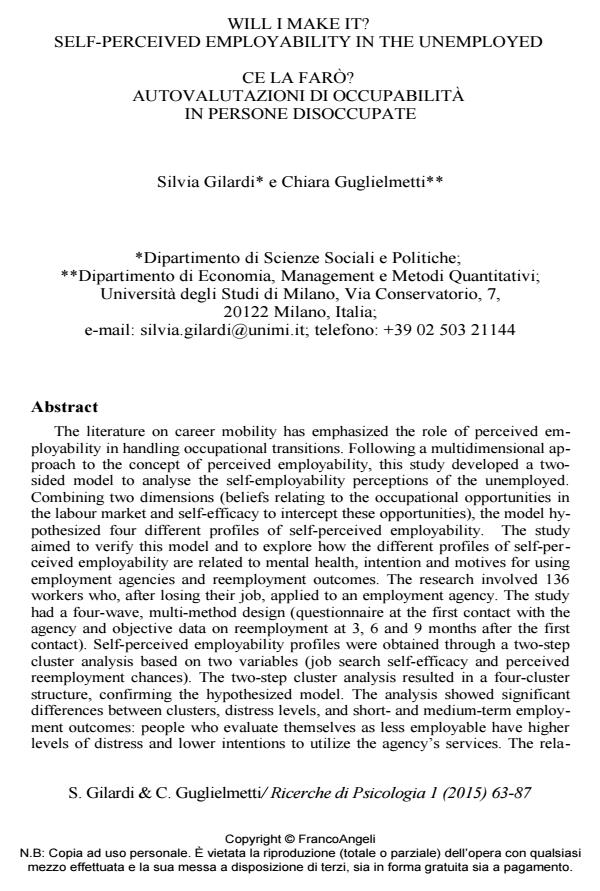Will I make it? Self-perceived employability in the unemployed
Titolo Rivista RICERCHE DI PSICOLOGIA
Autori/Curatori Silvia Gilardi, Chiara Guglielmetti
Anno di pubblicazione 2015 Fascicolo 2015/1
Lingua Inglese Numero pagine 25 P. 63-87 Dimensione file 284 KB
DOI 10.3280/RIP2015-001003
Il DOI è il codice a barre della proprietà intellettuale: per saperne di più
clicca qui
Qui sotto puoi vedere in anteprima la prima pagina di questo articolo.
Se questo articolo ti interessa, lo puoi acquistare (e scaricare in formato pdf) seguendo le facili indicazioni per acquistare il download credit. Acquista Download Credits per scaricare questo Articolo in formato PDF

FrancoAngeli è membro della Publishers International Linking Association, Inc (PILA)associazione indipendente e non profit per facilitare (attraverso i servizi tecnologici implementati da CrossRef.org) l’accesso degli studiosi ai contenuti digitali nelle pubblicazioni professionali e scientifiche
The literature on career mobility has emphasized the role of perceived employability in handling occupational transitions. Following a multidimensional approach to the concept of perceived employability, this study developed a twosided model to analyse the self-employability perceptions of the unemployed. Combining two dimensions (beliefs relating to the occupational opportunities in the labour market and self-efficacy to intercept these opportunities), the model hypothesized four different profiles of self-perceived employability. The study aimed to verify this model and to explore how the different profiles of self-perceived employability are related to mental health, intention and motives for using employment agencies and reemployment outcomes. The research involved 136 workers who, after losing their job, applied to an employment agency. The study had a four-wave, multi-method design (questionnaire at the first contact with the agency and objective data on reemployment at 3, 6 and 9 months after the first contact). Self-perceived employability profiles were obtained through a two-step cluster analysis based on two variables (job search self-efficacy and perceived reemployment chances). The two-step cluster analysis resulted in a four-cluster structure, confirming the hypothesized model. The analysis showed significant differences between clusters, distress levels, and short- and medium-term employment outcomes: people who evaluate themselves as less employable have higher levels of distress and lower intentions to utilize the agency’s services. The relationship between the employability profile and reemployment at 3, 6 and 9 months shows interesting trends. Our study contributes to the literature on employability, highlighting the relevance of considering different self-perceived employability profiles of unemployed people. Moreover, its suggestions can be useful for career counsellors in profiling workers who are at risk of psychological distress during occupational transitions and who could give up searching for a job.
Parole chiave:Perceived employability, job search self-efficacy, unemployment, reemployment, mental health, employment agencies
- The role of teaching staff in fostering perceived employability of university students Gerardo Petruzziello, Marco Giovanni Mariani, Dina Guglielmi, Beatrice I. J. M. van der Heijden, Jeroen P. de Jong, Rita Chiesa, in Studies in Higher Education /2023 pp.20
DOI: 10.1080/03075079.2022.2105830 - Employability & Competences Marianna Capo, Valentina Paola Cesarano, Maria Papathanasiou, Maura Striano, pp.341 (ISBN:978-88-6453-671-2)
- Self-Perceived Employability and Psychological Well-Being Among Italian Students and Graduates: A Three-Wave Cross-Lagged Study Gerardo Petruzziello, Rita Chiesa, Dina Guglielmi, Beatrice I. J. M. van der Heijden, Jeroen P. de Jong, Marco Giovanni Mariani, in Journal of Career Development /2025 pp.21
DOI: 10.1177/08948453241296805
Silvia Gilardi, Chiara Guglielmetti, Will I make it? Self-perceived employability in the unemployed in "RICERCHE DI PSICOLOGIA " 1/2015, pp 63-87, DOI: 10.3280/RIP2015-001003